Guru Rinpoche Taught “Mala Should Accompany You Like Your Shadow”– A Complete Buddhist Guide to Practicing with a Mala
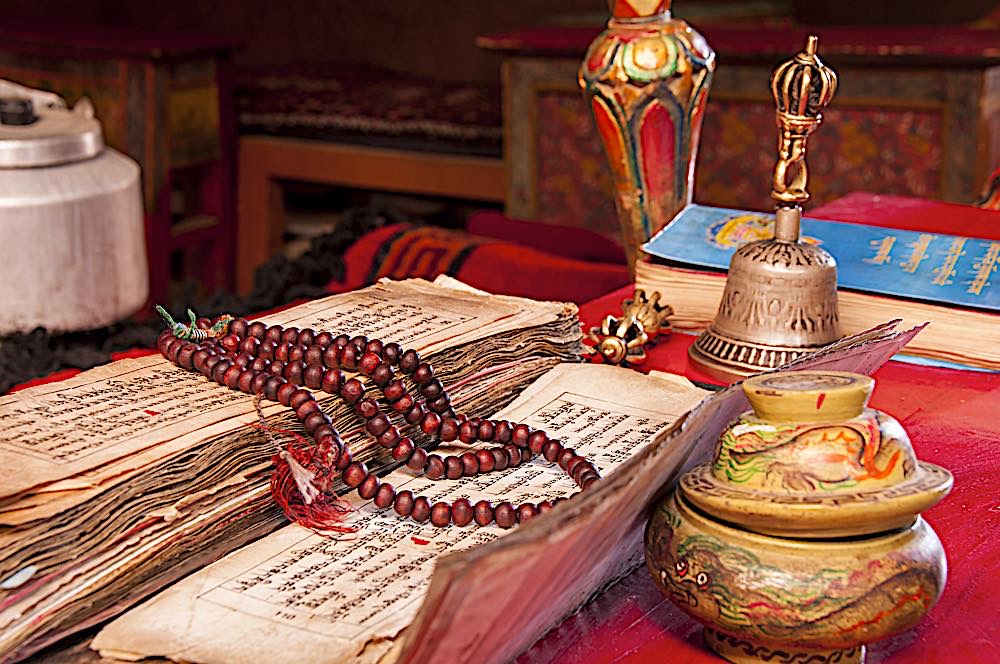
Why did the great Guru Rinpoche Padmasambhava teach your mala “should accompany you like your shadow”? What else did Guru Rinpoche teach regarding Malas?
What is a mala? Why is a mala special? What difference does it make how many beads, the size of beads or the color? Does a mala have to be blessed? How do you use it?
Why do some traditions consider it not only a sacred object, but one of the most important of Dharma objects, representing nothing other than Buddha’s Speech, the Dharma itself?
Why do a few traditions hold that mala is “just for counting?”
How do you use and choose a mala, bless a mala and use a mala? What materials are best for mala?
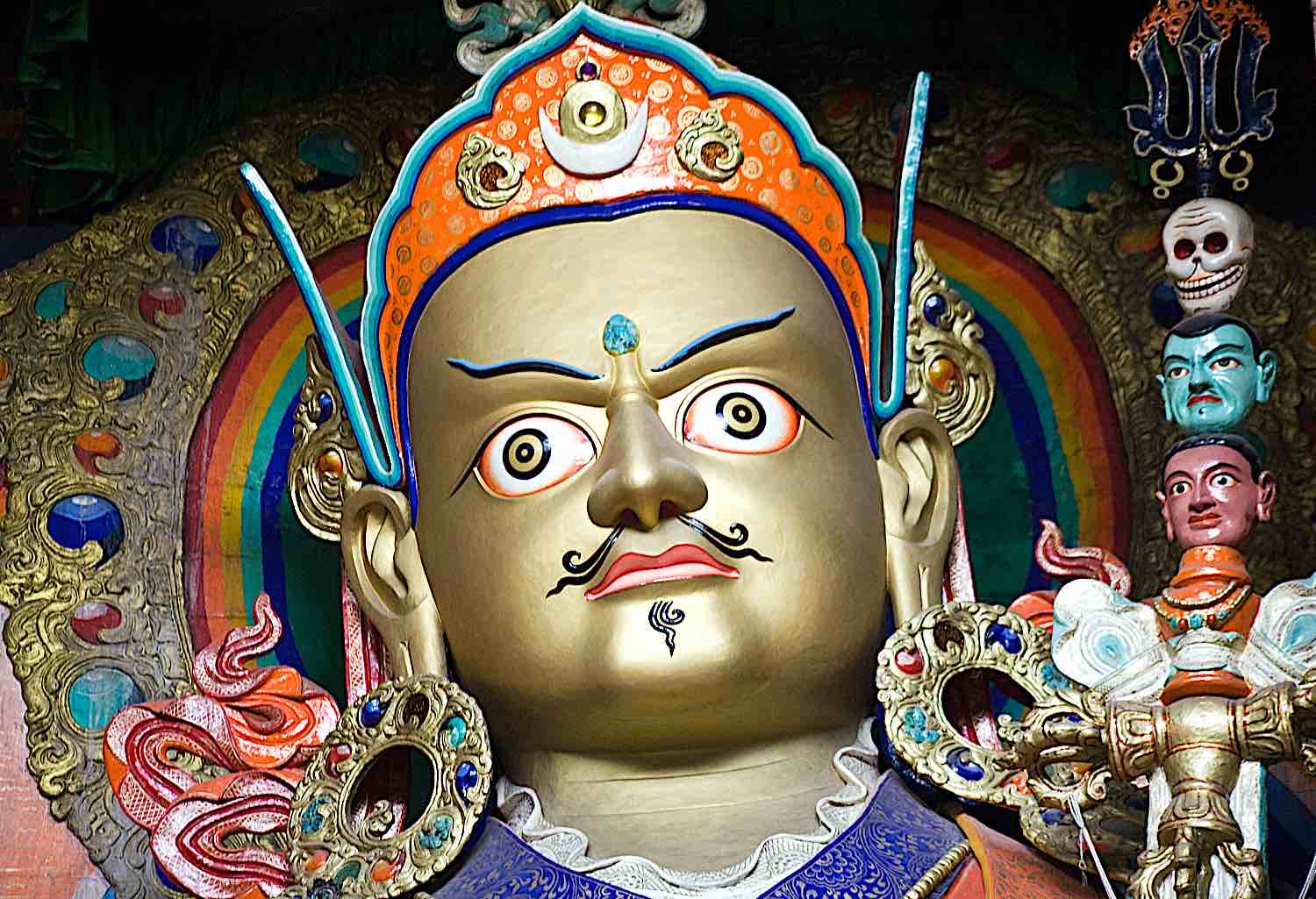
“Accompany like a shadow” or “Just for counting”?
Ask a Zen or Chan Buddhist, and the practitioner casually say, “It’s just for counting, nothing special. Just count” — although, to be fair, the same tradition holds that Sutra is “just for reading and instruction” nothing more. It’s a matter of perspective.
Ask most Mahayana Buddhist and the language would be one of sacred and precious respect: “It’s a sacred object.” All the rules that apply to Dharma objects apply, such as do not place on the floor, do not step over a mala, treat it with reverence, and so much more. And, then there’s the whole question of, can you wear a mala?
Inquire of a serious Tibetan Buddhist, where the entire Universe is sacred, and the likely answer will be more nuanced: “it’s none other than the deity itself.” This is the meaning behind Guru Rinpoche’s advice that “If your mala has been repeatedly blessed… it should accompany you like your shadow.
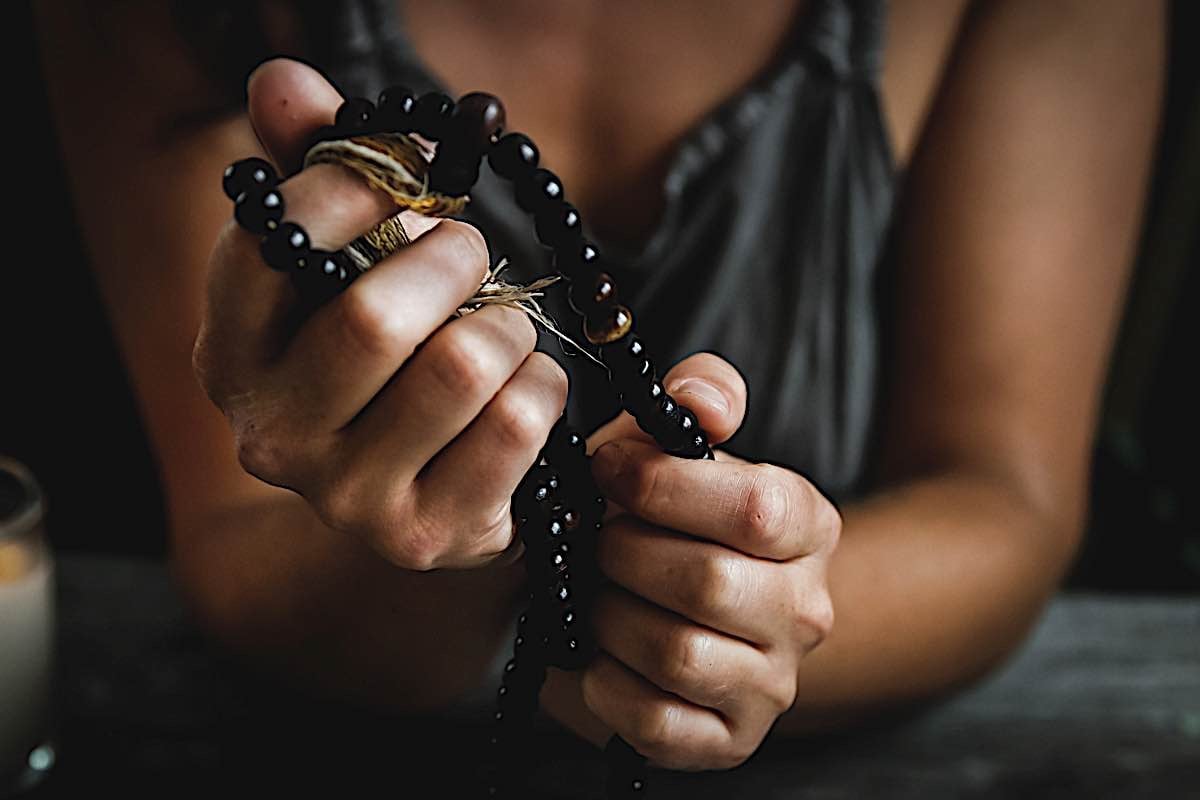
Depending on your perceptions and understandings, all of these questions determine how it’s made, who made it, what it’s made of, and how you use it. Then there’s the epic question of what you do when it “breaks” and does it mean something?
Tibetan Buddhists also emphasize mantra and counting retreats to bless our speech with Dharma speech. In this practice mantras are critical and malas empower the practice (either symbolically, or at a deeper level, depending on your view and faith.) In one practice, you visualize each bead as a Buddha and the entire mala string as a great mandala.
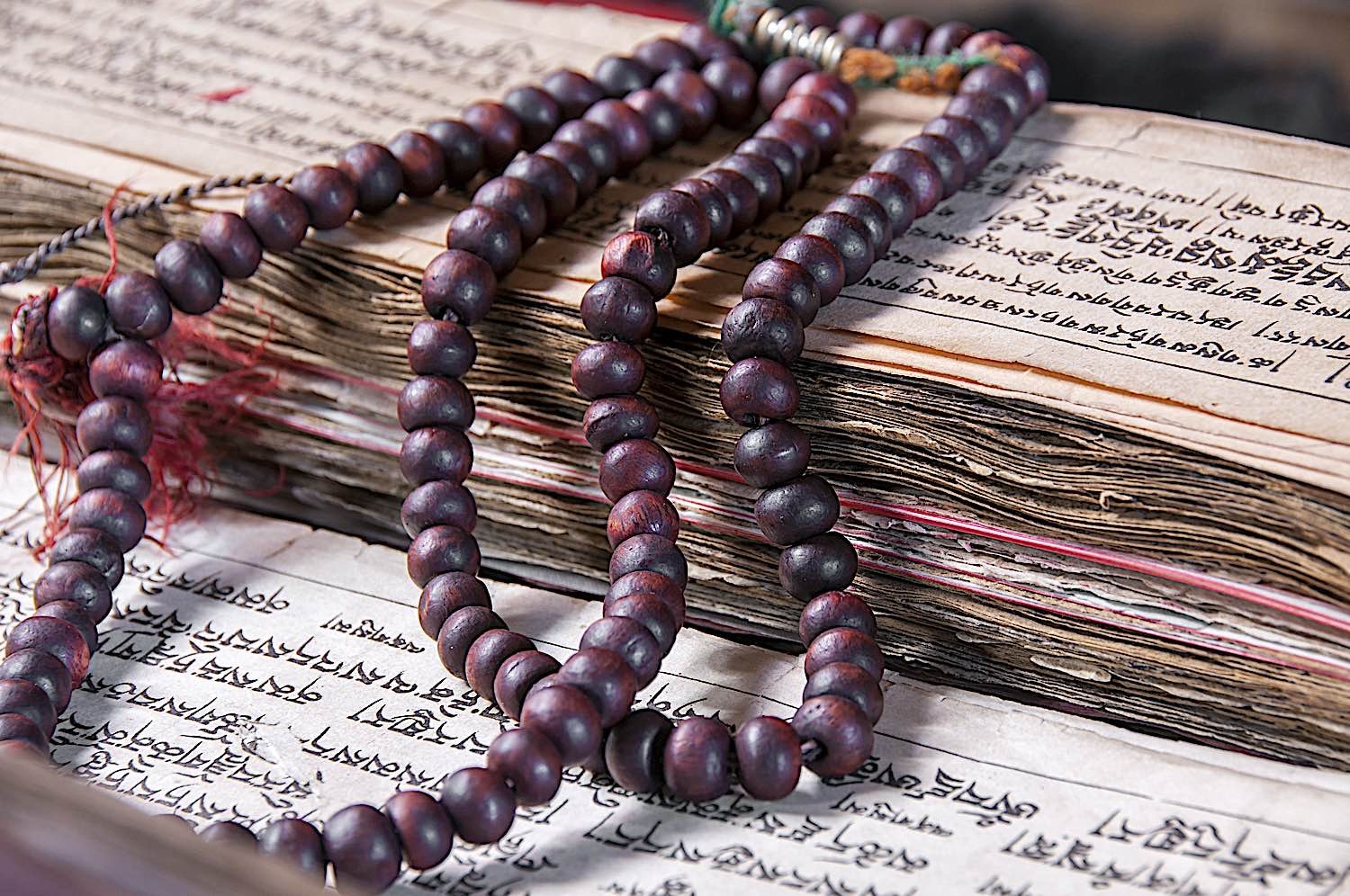
Sacred or “Just Counting?”
Gyatrul Rinpoche, in his book The Generation Stage in Buddhist Tantra, writes:
“Your mala represents not only the form of the deity but the speech of the deity as well. For example, if you recite the One-Hundred Syllable mantra, the guru bead represents the syllable OM and the other beads represent the remaining syllables.”
At this level a mala is not just sacred, but deity itself.
The great Guru Padmasambhava advised: “If your mala has been repeatedly blessed by great lamas, by your own teacher and by yourself as part of your deity practice, it should accompany you like your shadow.” Yet, at the same time, many teacher’s today discourage students from carrying their practice mala in their daily lives. How can a mala accompany you like a shadow, but stay on your meditation table?
So, which view is right? “Just for counting” or sacred object that should “accompany you like your shadow”? As with any skillful teaching in Buddhism, both views could be considered correct.
As with most things “Buddhist” — all views can be considered correct and non-contradictory.
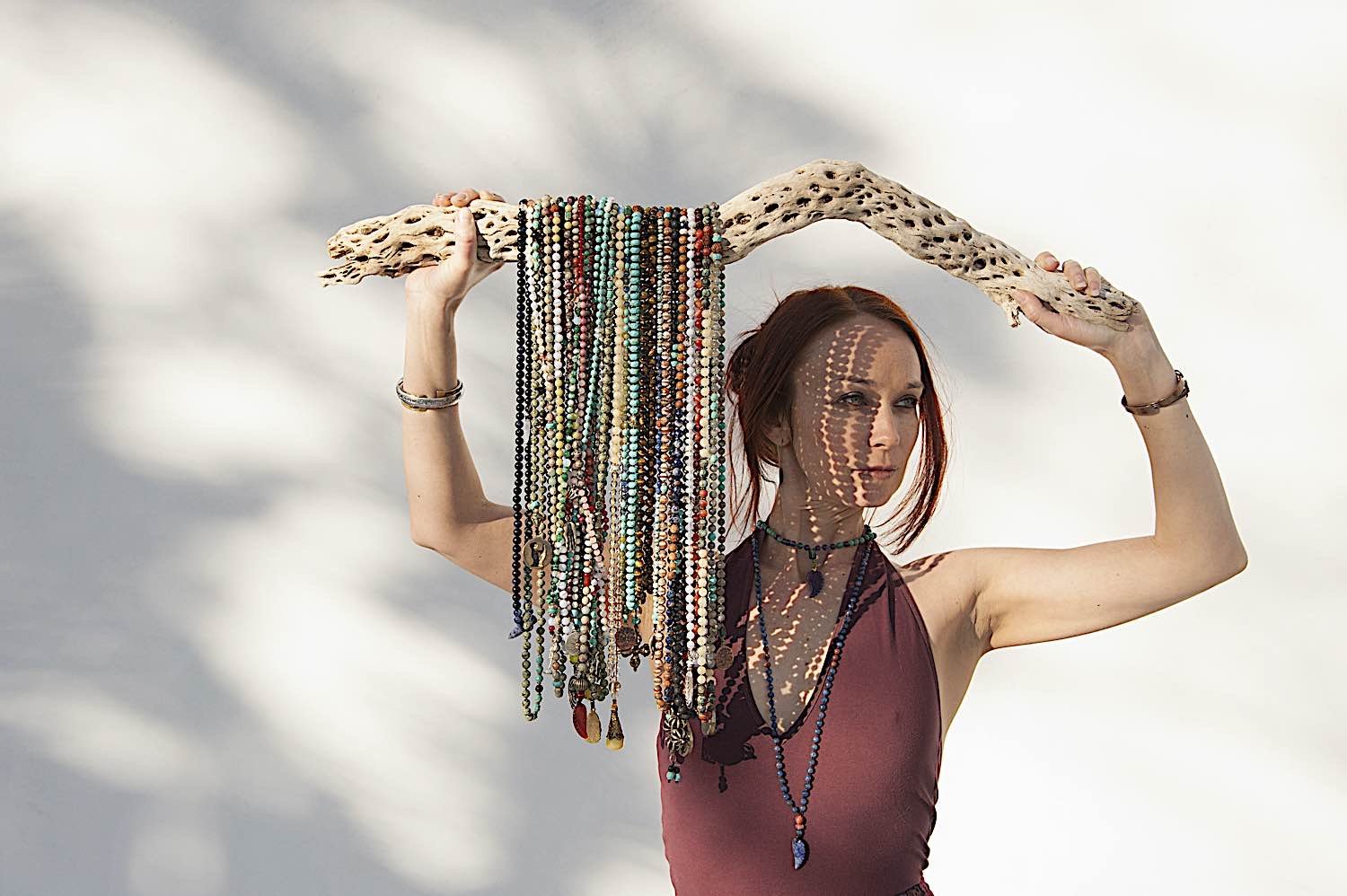
The Two Extremes: Sacred and Not
The Zen view tends to be deliberately provocative. “If you see the Buddha — kill him.” This is a riddle, a symbol, not a literal message.
On the other extreme malas are sacred representations of the body and speech: Buddha and Dharma. It’s a matter of respect, not superstition, however. In the same way, you could say a Thangka (painting) of Buddha is “just canvas” you can say malas are “just for counting.” But, for most of us, the moment the artist took brush to paper, to create a sacred image, it came to represent the Buddha. Therefore, sacred. As with all things Buddhist, there are two realities. One Buddhist teacher could say malas are “sacred”; another could say they are just “beads and string.” Both are right. In our dualistic understanding, there is room for both.

Can Mala’s be Worn?
Bardor Tulku Rinpoche, on the Shambala website advises on the care and use of malas:
“How should the mala be cared for and respected?”
Since one’s mala is a receptacle of the blessings of one’s recitation, it should not be put on the ground or in dirty places.
“Is it appropriate to wear a mala around one’s neck? or just around the wrist?”
It is appropriate to either wear one’s mala around one’s neck, or keep it in a pocket on one’s upper body. It is inappropriate to keep it in a pants pocket.”
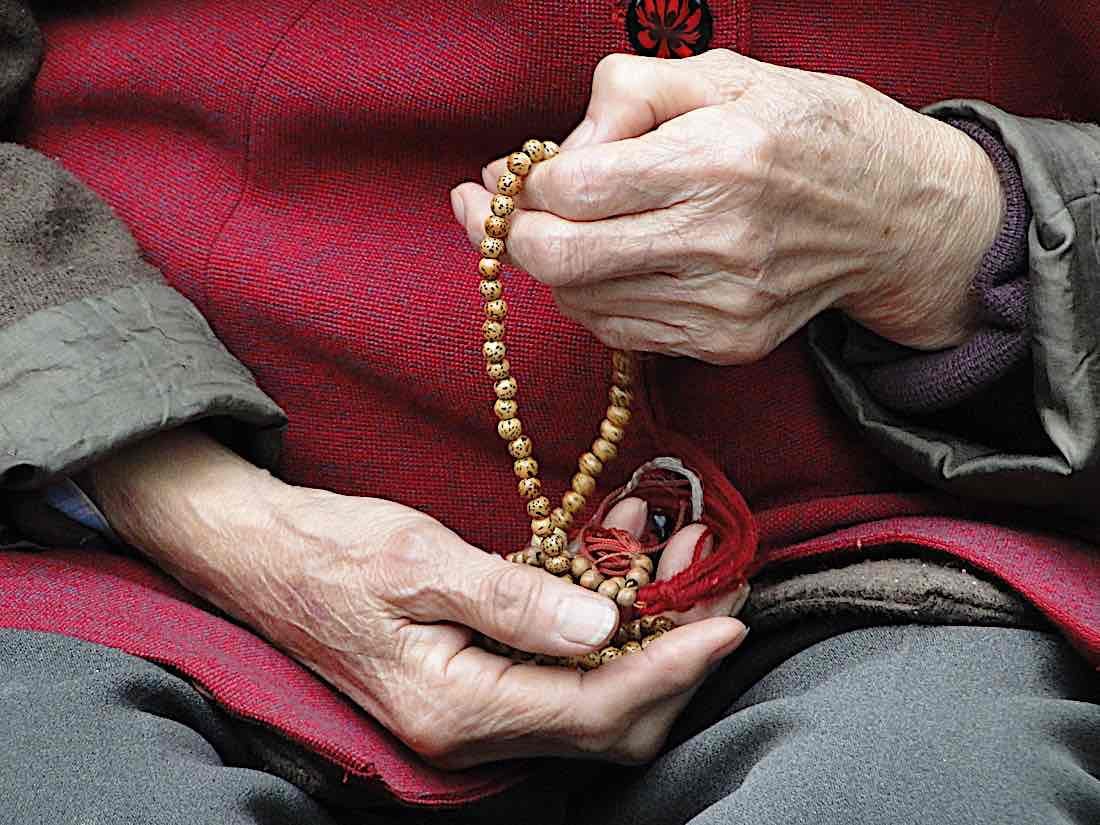
“Just count” is a Point of Emphasis Only
Why such a disparity? There’s less inconsistency than you’d imagine. If you actually asked a Zen Buddhist to throw his mala on the ground disrespectfully, that would never happen — except perhaps as a “teaching” moment. And, Zen Buddhists chant sutra and mantras. When a Chan or Zen Buddhist says their practice is “just sitting” it’s the same deliberate language choice as “malas are just for counting.” The reality is that Zen practice is not just about sitting.
Likewise, a much misunderstood “Zen/Chan” saying is “If you see the Buddha, kill him.” This symbolizes “killing our ego” not actually taking a Buddha statue and disrespecting the sacred relic. In these cases, the language chosen is a “skillful means” of teaching — not meant to be a literal instruction.

Grand statements such as “just sit” or “just count” or “kill the Buddha” are points of emphasis on the “emptiness” of both our own egos and all phenomena. It’s no different than a whack with a stick “to wake you up” from your teacher when you “just sit” in Zen/Chan.
Meanwhile, the Tibetan Buddhists include mala practice in “secret” practices, which inevitably include visualizations mantras, dos and don’ts, and activities — profound, sacred, deliberate acts that are meaningful and helpful. But, it is a mistake to think that if you accidentally carry your mala into the toilet you’ve ruined your 100,000 mantra recitation practice. It’s about state-of-mind, skillful teaching, and respect.

So, is a Mala Sacred?
In most traditions, emphatically, yes, in the same sense we imbue mantras with sacred intention. It all comes down to intention. At the ultimate level, you can say “prayer is empty” and “malas are empty” and “mantras are empty” but at our stage of practice, regardless of tradition, mantras are definitely not for “just counting” and throwing away. They are sacred, Holy objects. Whether you view the “power” of a mala — as with mantras — as symbolic, or profoundly powerful, they are still “sacred.”
In fact, in formal practice, just as we visualize ourselves as the deity to reinforce that things are “not as they appear” and other concepts, we likewise, reduce our mala’s to “emptiness” and bless them by visualizing them as a garland of deities. If we were dealing with absolutes, it would be disrespectful then to use your fingers to thumb back the visualized garland of deities. Visualizations train the mind. They’re not about rigid doctrine.
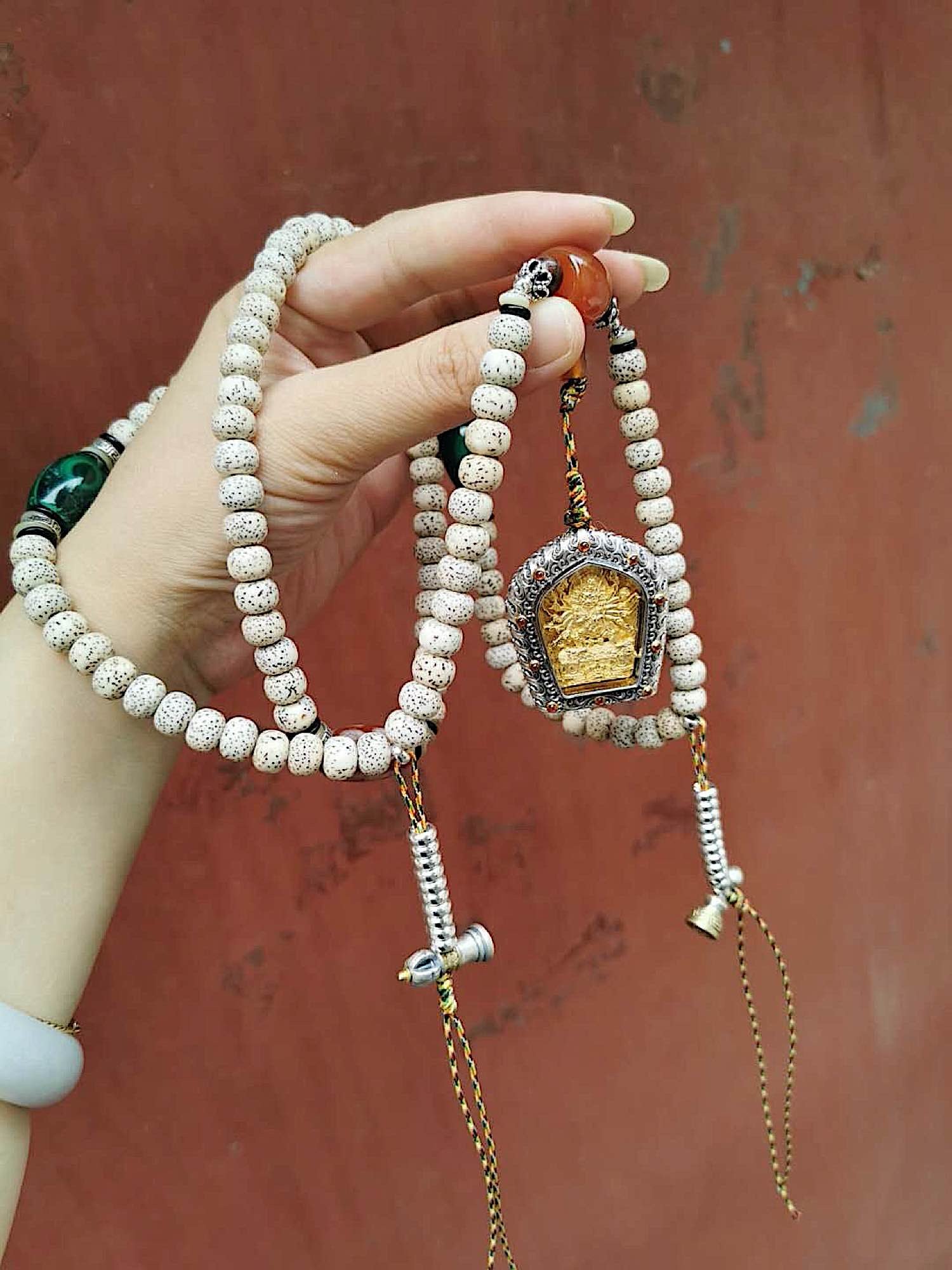
Guru Rinpoche clearly instructs us:
“It is very important to protect your mala from contamination by non-virtuous persons.”
It seems that the Great Teacher is inspiring fear and rigid doctrine. In fact, he is using skillful means to instruct us to remain mindful of our practice, moment-by-moment, even in our daily lives beyond practice.
In keeping with “sacred” Padmasambhava, says: “The best type of mala to use to increase the number of recitations is a mala made from some type of precious jewel (Tib. Tin O che). A mediocre type of mala is made from the seed of a tree or fruit, and inferior type of mala is made from wood, earth, stone or medicine.”

“Keep Your mala private.”
The most misunderstood instruction is probably “keep your mala private” which is attributed to the great Guru Padmasambhava’s teachings. Yet, it is also Guru Rinpoche who instructs us that our mala “must accompany you like a shadow.” These appear to contradict, at least for those of us not in retreat — secluded from the mundane world. In real life, daily life of the non-retreatant, it would not be possible for a mala to accompany you like a shadow, yet totally remain private.
Taking these instructions as rigid doctrine is as much a mistake as ignoring it. Guru Rinpoche’s teachings are among the most skilful and subtle of sacred Dharma teachings. On one hand, strong admonishments help us understand that our practice is sacred — not just our malas but all aspects of practice.

Depending on your view, most serious students view this advice in this way — that during a retreat or accumulation practice, such as a counting retreat — the mala used in retreat should be kept private, and, in fact, should not be moved from the practice table in front of your retreat cushion. On the other hand, when you venture off the cushion, most practitioners will have a mala — blessed by their teacher, and repeatedly used in mantra practice — which they wear publicly. This fulfils both “commitments.” Your retreat mala is private, but you also have a mala that “accompanies you like a shadow.”
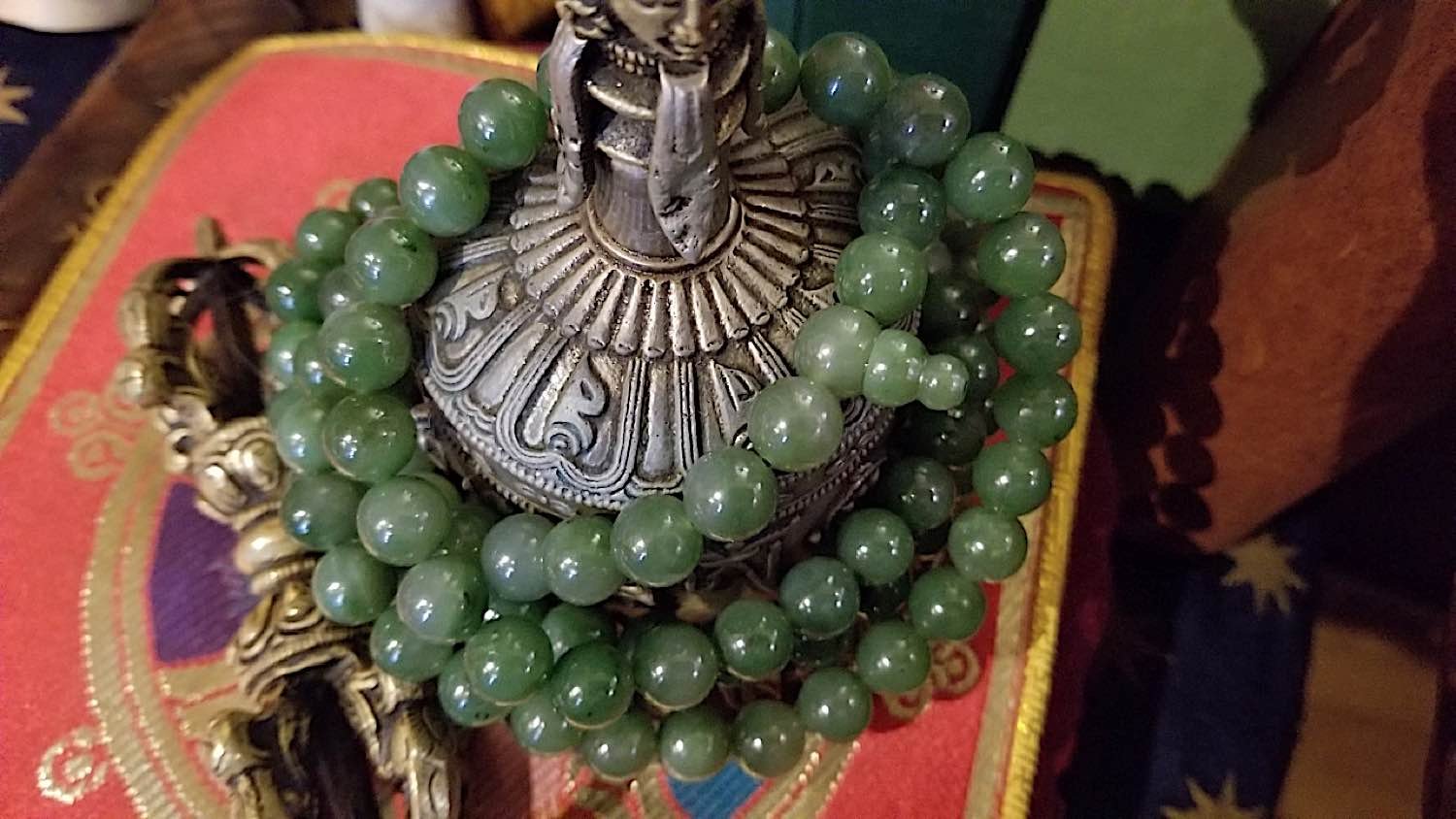
The number of beads
From a practical, point of view, the first question that arises is “how many beads?” or “Why 108 beads?”
In Buddhism, the number 108 connects us to our place in the Dharma. If the human form is represented by a five-pointed star contained within a circle to represent the Earth, we see 108ᵒ in each angle. Within us, the heart chakra is formed of 108 lines of energy or nadis and 108 pressure points or marmas.
On a cosmic level, the distance between the sun and the Earth is 108 times the diameter of the sun. The number 108 connects us both to ourselves and to the world around us.
In Tibetan Buddhism, there are 108 delusions to be purified.
Twenty-seven a so-called “quarter mala’ where four times around is a full 108. It is used for larger beaded malas. Twenty-seven is highly significant in Buddhism. The moon orbits the earth every 27 days, and moon days are sacred for practice in Buddhism. Twenty-seven is the only positive whole number that is exactly three times the sum of its digits. For longer mantras such as Vajrasattva’s 100-syllable mantra, many teachers advise students to do 27, 21 or 7 times a day.
Often malas will have extra “counter strings” attached, which track the tens and hundreds of repetitions if we’re in a counting retreat. Otherwise, you just keep track with paper of your totals.
For Formal Vajrayana Practice: Guru Rinpoche
In Gyatrul Rinpoche’s book The Generation Stage in Buddhist Tantra, he cites the advice of Padmasambhava regarding materials and practice protocols (don’t despair, however, if you can’t afford a “ruby” mala! the Bodhi Seed mala is relatively inexpensive and good for all practices!):
“A mala made from seashells, earth, wood or seeds from trees or fruit is meant to be used to accomplish peaceful sadhanas and peaceful action. A mala made from gold will accomplish expansive karmas. A red coral mala is best for accomplishing powerful sadhanas. A steel or turquoise mala is good for wrathful activity. A mala made from dzi or other precious stones can be used to accomplish any of the karmic activities you are doing.
A mala made from apricot stones will accomplish expansive ac tivity. A mala made from “lot ton” (a tiny, round black seed within a fruit) accomplishes powerful activity A mala made from raksha beads accomplishes wrathful practices. A mala made from bodhi seeds accomplishes all dharmas. Malas of bodhi tree wood accomplish peaceful karmas. A mala of mulberry beads accomplishes powerful karmas. Malas of mahogany wood accomplish wrathful practices. Malas made of ivory, especially from an elephant’s tusk, will accomplish all concerned activity.
Beads made of stone are good for expansive practice. Beads made of medicine are good for wrathful practice. Malas with many different types of jewels are good for any practice. However, I suggest that you not attempt to create a mala with a lot of different beads on it because, unless you know which combinations are effective, you may cause a non-positive result.
Next, the text mentions the different kinds of benefits that are derived from using different types of malas. An iron or steel mala multiplies the virtue that is accumulated with each recitation in a general way. A copper mala multiplies each recitation four times. A raksha mala multiplies each recitation by 20 million, and a pearl mala by 100 million. A silver mala multiplies by 100,000 and a ruby mala by 100 million. A bodhi seed mala manifests limitless benefits for any form of practice, be it peaceful, expansive, powerful or wrathful.
You should all know the mala’s meaning and the best way to string it. String your mala using three, five or nine strings, and no other number. Three strings symbolize the three kayas, five strings symbolize the five buddhas, and the nine strings symbolize the nine vehicles.
The main guru bead may be composed of three beads, symbolizing the three vajra states of being, the three kayas. The smallest bead on the outside should be blue, perhaps made of lapis. The color blue symbolizes the unchanging mind of ultimate truth. The bead in the middle should be red, to symbolize vajra speech, and the innermost bead should be white, to symbolize the vajra body.
Your mala must be blessed by a lama, and you should constantly bless your mala yourself by imbuing it with energy. You must put energy into your mala before counting recitations with it, to produce real benefit.
You should clean your mouth and hand, and then your mala, before using it. You may also scent it with sandalwood oil.
Next, generate yourself as the deity, place the mala in your left hand and arrange the beads with the guru bead placed vertically in the center. Recite the mantra that transforms all dharmas into the awareness of their true nature: OM SWABAVA SHUDDO SARVA DHARMA SWABAVA SHUDDO HAM. This mantra cleanses and transforms impure perceptions into the awareness of emptiness.”
From emptiness, the guru bead appears as the central deity in the mandala, and the other beads appear as the members of the entourage. This part of the practice is the meditation upon the samayasattva. Next, invoke the jnanasattva. Invite the primordial wisdom beings to come forth, hooking them so that they dissolve into the samayasattva, just as you would in a sadhana. Invite the wisdom beings to come from their pure lands into the space in front of you. They then dissolve into your mala and remain firm there. Thus, every part of your mala is the entire mandala. This includes the central deity, entourage, lotus seats, ornaments, hand emblems, colors, etc. Blessing your mala in this way multiplies each syllable of whatever mantra you then recite 100,000 times, besides causing good karmic results. Therefore, it is extremely important to do this.
Guru Padmasambhava said, “Whenever you recite peaceful mantras, use the tip of your thumb to count the mala. When reciting expansive mantras, use the third finger. Use the ring finger and thumb when reciting powerful mantras, and use the little finger when reciting wrathful mantras.” Use only your left hand to count mantras. The right hand is but rarely used; for instance, in some wrathful practices. Some books teach the use of both hands, but do not use the right hand only.
Whatever kind of practice you are doing, whether peaceful, wrathful, powerful or expansive, always be aware that the thumb is a vajra hook which hooks spiritual powers, deities and other blessings. It is also easy to move the beads with your thumb.”

Vajrayana Mala Care Guide
Khenpo Gyaltsen in Lamp Illuminating the Path to Liberation: An Explanation of Essential Topics for Dharma Students has similar advice:
“When reciting the essence mantra of your deity, do not use another mala. Never place your mala on the bare ground, leave it lying around, let it pass under one’s feet and so on. Do not let others touch it, and in particular keep it away from the hands of people with damaged sacred commitments, people who are obscured, or who do not share the same sacred commitments as oneself. Do not pass it excessively slowly through your hands while counting mantras.
You should not use a mala with uneven sized beads, with crooked beads, cracked beads, the wrong number of beads, beads of inferior color or shape, or malas that are of a different type or mixed. Do not wear a mala as jewelry. Do not use a mala that comes from a very negative person. Do not use your mala for calculating and other such things. Do not hold it with pretense or to show off. Do not use a mala that has not been consecrated.”

For Zen Practitioners
Whatever works! Just count.
For Most of Us
Common sense: treat with respect, follow the advice of your own tradition — the rest is up to you.
3 thoughts on “Guru Rinpoche Taught “Mala Should Accompany You Like Your Shadow”– A Complete Buddhist Guide to Practicing with a Mala”
Leave a Comment
More articles by this author
Search
Latest Features
Please support the "Spread the Dharma" mission as one of our heroic Dharma Supporting Members, or with a one-time donation.
Please Help Support the “Spread the Dharma” Mission!

Be a part of the noble mission as a supporting member or a patron, or a volunteer contributor of content.
The power of Dharma to help sentient beings, in part, lies in ensuring access to Buddha’s precious Dharma — the mission of Buddha Weekly. We can’t do it without you!
A non-profit association since 2007, Buddha Weekly published many feature articles, videos, and, podcasts. Please consider supporting the mission to preserve and “Spread the Dharma." Your support as either a patron or a supporting member helps defray the high costs of producing quality Dharma content. Thank you! Learn more here, or become one of our super karma heroes on Patreon.
Lee Kane
Author | Buddha Weekly
Lee Kane is the editor of Buddha Weekly, since 2007. His main focuses as a writer are mindfulness techniques, meditation, Dharma and Sutra commentaries, Buddhist practices, international perspectives and traditions, Vajrayana, Mahayana, Zen. He also covers various events.
Lee also contributes as a writer to various other online magazines and blogs.












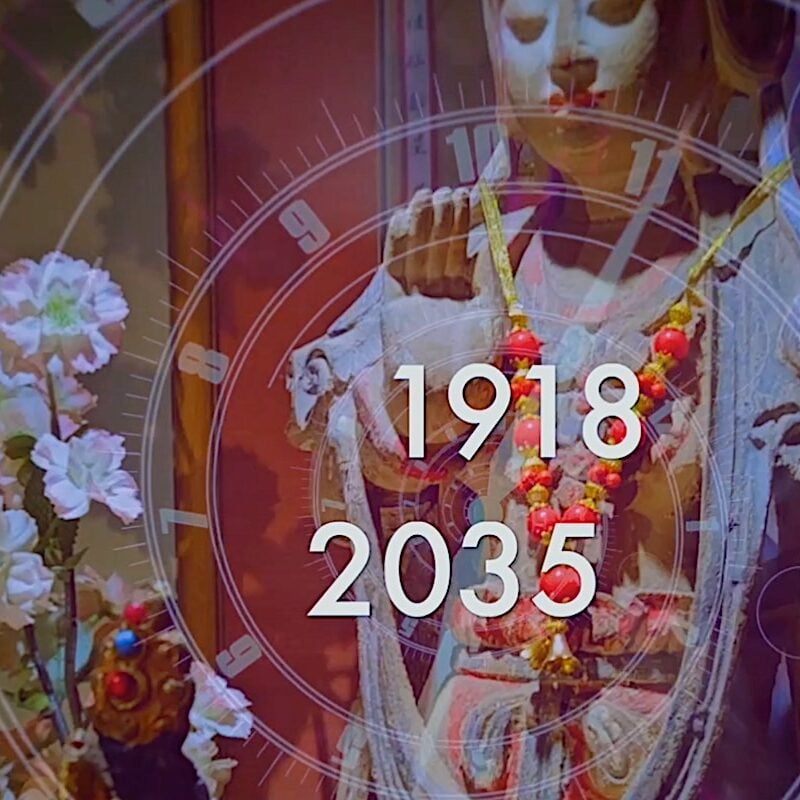
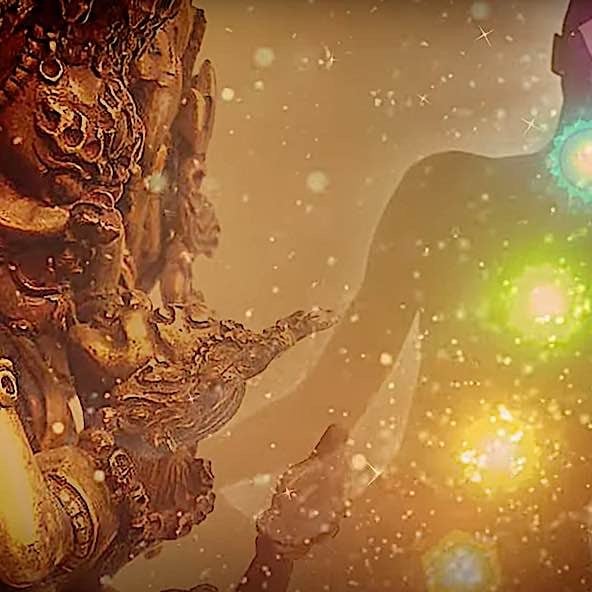





Hello,
I would appreciate your very kind advice.
When I do my prayers in the morning, I hold the dharma wheel on my left hand and use my right hand for the mala beads.
I tried a few times to use my left hand for the mala beads and my right hand for the dharma wheels but couldn’t quite turn the dharma wheel smoothly.
I was just wondering whether this is all right.
Dear Cindy, Yes, it’s perfectly fine (so I’ve been told by my teacher), although you should always ask your own teacher. Normally they’re interchangeable. After all, some people are left-handed, some are right. Normally, teachers, today say “dominant hand” (meaning if you’re right handed that’s your dominant hand.) So, someone who is left handed normally switches. But it’s not rigid unless you’re doing a specific practice (for example, Mother Tantra everything is counterclockwise, Father Tantra is clockwise — but even that’s not rigid because you should never spin a prayer wheel counter-clockwise ) I wouldn’t worry, you are doing your mantras and sending out the mantra’s blessings from your heart (and your prayer wheel) and that’s what really matters. In kindness, Lee
I have always wondered about the significance. Thank you for this insightful piece.